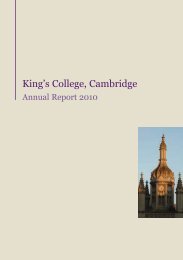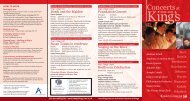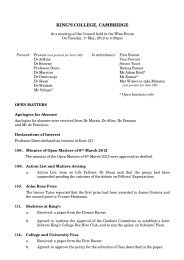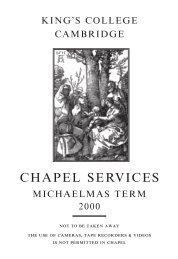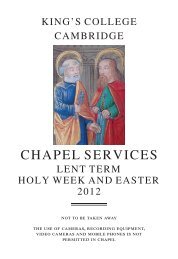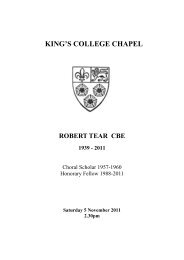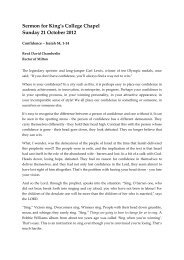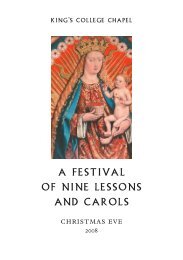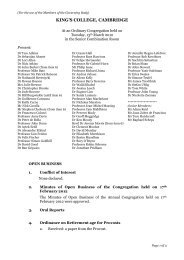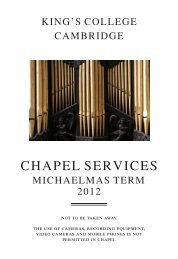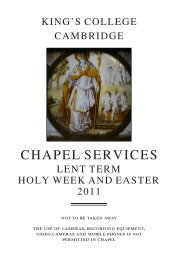Part 2 (Obituaries) - King's College - University of Cambridge
Part 2 (Obituaries) - King's College - University of Cambridge
Part 2 (Obituaries) - King's College - University of Cambridge
You also want an ePaper? Increase the reach of your titles
YUMPU automatically turns print PDFs into web optimized ePapers that Google loves.
126<br />
OBITUARIES<br />
Working as an astronomer involved a fair amount <strong>of</strong> globetrotting, and<br />
David and family moved to Texas in 1968, where they had already spent<br />
some time. He became Pr<strong>of</strong>essor <strong>of</strong> Astronomy and Associate Director <strong>of</strong><br />
McDonald Observatory, where he kept a large pegboard covered in<br />
different-coloured golf tees which he used to schedule telescope time for<br />
McDonald observers. No one except David could ever figure out how<br />
it worked.<br />
David was a central figure in a 1973 expedition to Africa, in which the<br />
Einstein prediction <strong>of</strong> the effect <strong>of</strong> the sun’s gravity on bending the path <strong>of</strong><br />
light from a star was tested again. He was appointed Jack Josey Centennial<br />
Pr<strong>of</strong>essor in Texas from 1977 until 1986 when he retired, and had a very<br />
fruitful collaboration with fellow scientists Brian Warner and Ed Nather;<br />
they revived the lunar occultation programme that David had been working<br />
on in South Africa and instruments were developed which enabled the<br />
investigation <strong>of</strong> objects with rapid light variations. Through their work, the<br />
field <strong>of</strong> “high-speed astronomy” was born. David had many PhD students<br />
whom he supervised with care and generous hospitality. Some projects<br />
required observations to be made from several different locations, and David<br />
excelled in making the travel arrangements so that some could go to India,<br />
some to South Africa and some to Perth in Australia. He contacted National<br />
Geographic to support the funding, contacted the embassies in the different<br />
countries to expedite the scientists’ passage through customs and contacted<br />
the airlines to make sure that the equipment could be monitored as it<br />
came on and <strong>of</strong>f the planes. The Australians began to recognise the name<br />
Dyvie Divvens.<br />
He was a vibrant and extrovert scientist, renowned for his singing and<br />
humming at home, in the laboratory and in the corridors, which seemed to<br />
get louder as he got older; he could burst into song at any occasion. A<br />
colleague reports how an experiment to measure the angular diameter <strong>of</strong> a<br />
star seemed to be going badly as a cloud completely covered the view through<br />
the telescope <strong>of</strong> the target star; but David sang theWelsh hymn God <strong>of</strong> our Fathers<br />
in stentorian tones and the cloud moved away for just long enough to allow<br />
the measurement to be taken. He also tested the acoustics <strong>of</strong> a potential



